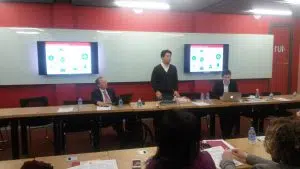On Tuesday, 26 January 2016, the eleventh Shanghai Social Studies Colloquium (SSSC) took place at the Shanghai campus of ESSCA School of Management. The SSSC is an initiative that provides a forum for international and Chinese scholars of various disciplines of the social sciences based in the city of Shanghai and its surroundings. They can present and discuss their research, so as to exchange critique and research ideas, improve their research output, network and socialise, with a view to developing collaborative research projects. The tenth edition of the SSSC had been held last November with a contribution of Prof. Dr. Wei ZHAO, Associate Professor of International Management at ESSCA.
Economic performance and competitiveness is intricately linked to innovation. In a macro-economic environment characterised by uncertainty, innovation ensures efficiency and productivity. In order to obtain first-hand insight into how investment decisions are taken, growth sectors predicted and innovation opportunities in China detected, the Shanghai Social Studies Colloquium welcomed
• Dr. Jonathan WOETZEL, Director of the McKinsey Global Institute and Director of McKinsey & Company
• Mr. Jeongmin SEONG, Senior Fellow of the McKinsey Global Institute
Just back from the World Economic Forum in Davos and drawing upon lessons of a recently published report entitled ‘The China Effect on Global Innovation’, the speakers categorised four archetypes of innovation and identified key drivers of innovation in industries that outperform China’s ‘new normal’ of slowing economic growth.
Discussing the report, Woetzel started out by explaining why they focused on innovation. He pointed out that every nation is getting older. China, in particular, is already looking a lot more like a developed country in terms of demography. Therefore, labour costs are increasing and only productivity can help China remain competitive. But that means it costs much more money than before to obtain the same GDP growth. Hence, ‘total factor productivity’ is the government’s target. ‘Ultimately, we have to get smarter on what we want to save on, Woetzel said.

Jeongmin SEONG speaks about innovation.
Seong then took over and asked the roundtable audience for a short show of hands on who thought that ‘China is innovating’. The audience confirmed the general trend, he said, that foreigners are pessimistic while Chinese are more optimistic about innovation in China. In the report the authors inquired what indicators could measure innovation and Seong went on to identify four archetypes of innovation as defined by McKinsey:
• Customer-focused innovation
• Efficiency-driven innovation
• Engineering-based innovation
• Science-based innovation
According to the indicators provided, China is rapidly catching up in consumer-focused & efficiency-driven innovation. At the same time, China is still lagging in engineering and science-based innovation.
For customer-focused innovation for example, it has to be understood that in an immensely big market like China even a niche is of tangible size. Therefore, revenue structures in China are different than for regular domestic market leaders around the world.
Concerning efficiency-driven innovation, it can be argued that China’s ecosystem is unique. Geographically delimited industrial clusters are an important aspect of economic development. Prototyping & manufacturing in the Pearl-River Delta near Shenzhen is extremely conducive for example.
When analysing engineering-based innovation, the first condition for success in this archetype of innovation was market creation. The government creates demand and promotes national champions to thrive in a specific market segment – infrastructure is a good example. This trend will continue as China’s government identified ten industries of strategic relevance in the ‘Industry 2025 Plan’. Clustering also helps in this respect, but innovation is sometimes impeded, as there is little competitive pressure from foreign companies that generally lack direct market access. Therefore, further business model innovation in this sector is needed.
Finally, science-based innovation has been rapidly increasing and seems very positive at first sight. However, McKinsey’s indicators show that China is strong in low-cost research and development (R&D) but is still lagging behind in more sustainable science-based innovation – a fact exemplified by a relatively low number of triadic patents (patents that are registered in more than three countries at the same time). Opportunities in sectors such as drug discovery or genomics are nevertheless promising.
In conclusion, it can be argued that customer-focused innovation is rapidly improving and especially sectors such as internet-enabled innovation in services is booming.
Coming back to the title of the report, Woetzel and Seong highlighted the question of the ‘China effect’ on global innovation once more. Arguably, China will impact the global innovation landscape. Overall, the world is likely to see a positive absolute effect on innovation. Hence opportunities for both Chinese and foreign companies exist. Accelerating the China effect may make innovation cheaper, faster and more global.
During the subsequent round of Questions and Answers, the authors highlighted a couple of opportunities. Among them, business model innovation – especially in the realm of next-generation manufacturing, 3D and the Internet of Things promise high growth potential for innovation. Mr. Jeongmin SEONG gave various examples of consumer-focused innovation emphasising internet applications paired with rapid market penetration and prompt adoption by Chinese consumers. Jonathan Woetzel concluded the discussion by reiterating that the Chinese market knows no niches; instead, he posited: ‘Imagine a critical mass with incentives and a lot of money – You put these together and you get innovation’.
The lively discussion in the plenary was followed by an informal exchange during a networking dinner.
This eleventh SSSC welcomed researchers from a variety of institutions including East China Normal University, International Business School Suzhou of Xi’an Jiaotong Liverpool University, Shanghai Normal University, Tongji University, University of International Business and Economics, Beijing, Shanghai International Studies University and Donghua University but also practitioners from the corporate world and media representatives.
All papers and the authors’ profiles of the tenth SSSC and of previous SSSCs can be read and downloaded under http://www.shanghai-review.org/sssc/
The SSSC is an ongoing event and takes place approximately every eight weeks.
The 12th Shanghai Social Studies Colloquium is scheduled for Tuesday, 8 March 2016, 18h00 CST. ESSCA will be pleased to welcome Dr. Frauke AUSTERMANN, Head of Campus of International School of Management (ISM), Cologne, and associate researcher of the EU-Asia Institute.
Dr. AUSTERMANN will discuss recent trends in the fashion industry testing hypotheses with the Chinese research community.
FURTHER READING:
Please find further information on innovation research online:
• McKinsey Global Institute – ‘The China Effect on Global Innovation’




